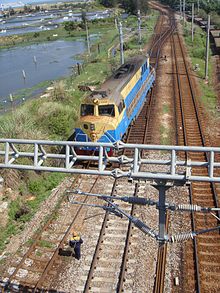Hainan Western Ring Railway
| Hainan Western Ring Railway 海南西环线 |
|
|---|---|
 |
|
| Overview | |
| Locale | (Hainan) |
| Termini |
Haikou Railway Station Sanya Railway Station |
| Services | 1 |
| Technical | |
| Line length | 363.8 kilometres (226.1 mi) |
| Track gauge | Standard |
The Hainan Western Ring Railway (Chinese: 海南西环线; pinyin: Hǎinán xi huán xiàn) is a standard-gauge railway running along the coast of the western half of Hainan Island in South China. It connects the provincial capital Haikou on the island's north coast with Sanya, the major city on Hainan's south coast. The rail line is 363.8 km long; its terminals are Haikou Railway Station and Sanya Railway Station. Cargo trains enter this railway from Zhanjiang, Guangdong at the South Port of the Guangdong–Hainan Railway.
The Hainan Western Ring Railway has a long history, some of its sections dating to World War II. It has achieved its present form upon the completion of a major expansion and upgrade project in 2005. After that, the Hainan Western Ring Railway (including a few minor side branches) remained the island's only railway until the opening of the Hainan Eastern Ring High-Speed Railway in 2010, which connects to the Western Ring at its both end points.
As of 2012, the Hainan Western Ring Railway is primarily used for freight, and has only very limited passenger service. The new Hainan Western Ring High-Speed Railway, primarily for passenger service, will be constructed along a fairly similar, but slightly shorter (344 km) route.
The Hainan Western Ring Railway has a complicated history.
The first railways on Hainan, which were later incorporated in the Hainan Western Ring Railway, were constructed during the Japanese occupation of the island during WWII. One of these lines connected the iron ore mine at Shilu with the Basuo Harbor on the island's west coast. The 53-km line was built in 1940-1942 to the Japanese 3 ft 6 in (1,067 mm) gauge, using the labor of some 50,000 Chinese workers. It was opened in the spring of 1942, but largely destroyed by a typhoon the same summer. Rebuilt in a more capital way, it reopened in May 1943.
...
Wikipedia
